Anthropomorphic clay pipes are one of the most beautiful and interesting creations of Mississippi cultures. These monuments developed from around 1500 BC. to the 12th century CE, from the simplest forms to pipes, the bowls of which took an anthropomorphic or zoomorphic shape and often depicted mythological characters.
Due to their beauty, pipes have been the subject of research for many decades. However, specialized analyzes to determine whether they were used for smoking and what they were consumed are a relatively new research perspective, and each publication on this issue provides us with new and extremely interesting information.
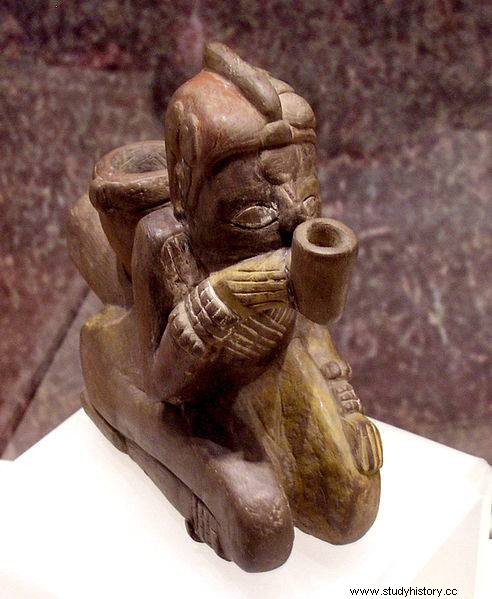
Anthropomorphic figurative Mississippi culture pipe from Spiro site © Herb Roe released under license CC BY-SA 3.0, via Wikimedia Commons
This year, a paper was published on two Mississippi culture pipes from the modern Arkansas state. This text presents the results of research on them and a sketch showing extremely interesting indigenous communities called Mississippi cultures.
Mississippi Cultures
Communities that developed in the vast area of the Mississippi River basin from 700 to 1600 AD have been called by archaeologists Mississippi cultures . They are related to the last phase of the development of the so-called Mound Builders, i.e. archaeological cultures (with a common origin and characteristic features) developing in this area. One of their most important attributes are earthen mounds. The oldest such monumental structures date back to the archaic period (8000-1000 BC). They remained a distinguishing feature of the communities inhabiting the Mississippi basin until the European conquest.
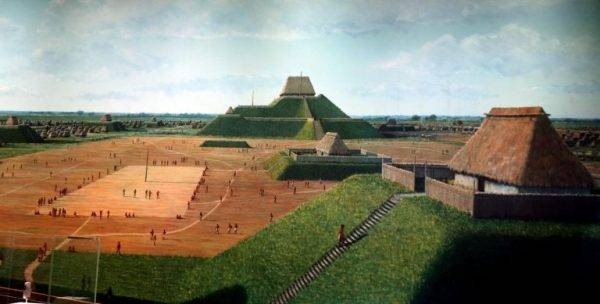
Artistic reconstruction of the city of Cahokia showing the square and earth mounds with constructions at the top of Prayitno, published under the CC BY 2.0 license, via Wikimedia Commons
In order to best reflect the multitude and diversity of peoples that make up the Mississippi culture, the researchers used the plural in the name. However, they are characterized by a number of common features - the most important attributes include:continuing the tradition of constructing monumental earth mounds, iconography depicting mythical figures and aesthetics referred to as the Southeast Ceremonial Complex, also known as Southern Cult . In addition, one of the most beautiful and specific types of monuments are richly decorated copper plaques, made with the technique of cold forging and annealing.
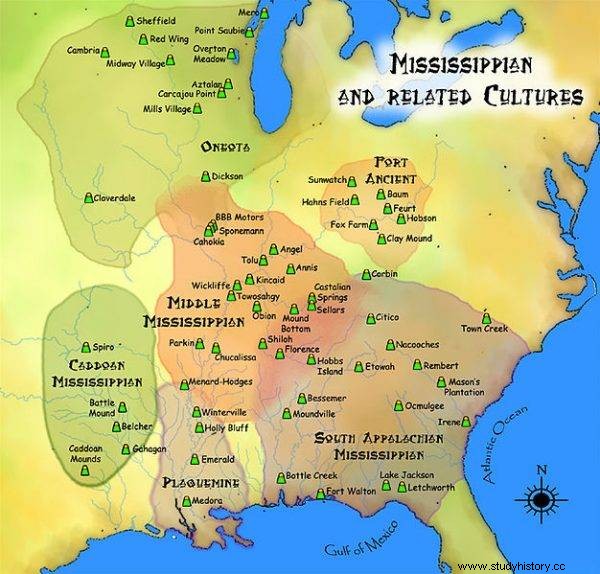
Mississippi Cultures Development Area by Heironymous Rowe, published under license CC BY-SA 3.0, via Wikimedia Commons
When presenting the outline of Mississippi cultures, it is impossible not to mention the most important archaeological site, which was Cahokia . This center developed from 900 to around 1250 CE. in what is now Illinois. During its heyday, at the beginning of the 12th century CE, it covered an area of 16 km2, on which over 120 earth mounds were erected. The estimated population of the city during this period was greater than that of London, making Cahokia one of the largest cities in the world. Accurate data on the demographics of this center is still hotly debated in academia.
Oldest pipes in North America
Items that archaeologists refer to as smoking pipes appeared in the Mississippi basin around 1500 B.C. Initially, they were simple straight tubes. Around 100 B.C. they gradually took a V-shaped form to eventually transform into anthropomorphic and zoomorphic pipes, characterized by high aesthetic value. Tobacco was used in North America long before the arrival of Europeans. To date, the oldest documented tobacco-related discovery dates back to Utah 12,000 years .
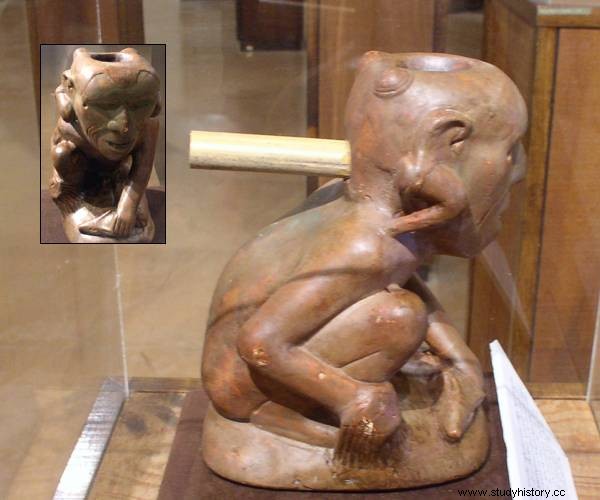
Anthropomorphic pipe of Mississippian cultures "Lucifer" from Spiro stand © H. Rowe, published under license CC BY-SA 3.0, via Wikimedia Commons
Tobacco traces on archaeological monuments can be detected using physicochemical analyzes which indicate the presence of specific biomarkers. Such a characteristic indicator is naturally nicotine. The analyzes also make it possible to determine what other plants have been eaten or smoked. For example, a pipe dating back to 3500 years ago comes from the area of the present Alabama state. Physicochemical analyzes indicate the use of a mixture of tobacco and datura in it. This plant has strong hallucinogenic properties.
A team of scientists from the United States also tested two anthropomorphic pipes from the Osceola site in Arkansas. The monuments most likely presented mythical figures related to the Oneot style and the widespread iconography of the Southeast Ceremonial Complex . To clarify the period in which they were used, C14 dating was used, which indicates the period between 1410 and 1457 CE. Organic residues were tested for the determination of biomarkers. Gas chromatography (GC-MS / MS) was used for this.
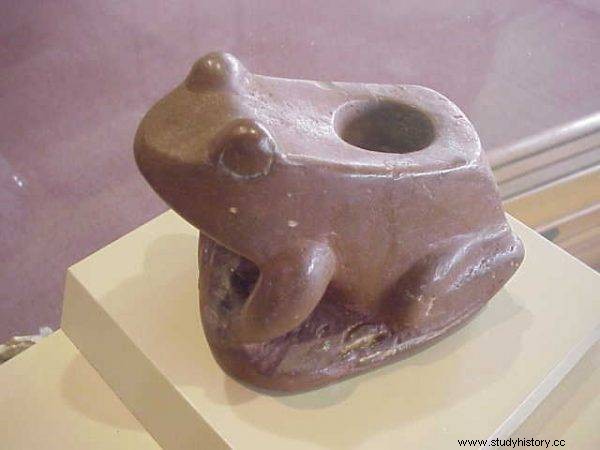
A zoomorphic Mississippi pipe in the form of a frog © Mary Harrsch, published under license CC BY-NC-SA 2.0, via Wikimedia Commons
The analysis showed the presence of nicotine in both pipes. In addition, in one case, terpenes were found that were associated with peppermint. Remains of pine resin were also observed. Researchers believe that this is the residue of setting fire to dried plants. Unfortunately, the method of lighting the pipe cannot be determined more precisely.
Tobacco in the indigenous peoples of North America was not consumed solely for recreational purposes. Smoking was likely to have deep ritual significance as evidenced by the context of finding pipes, at least in the positions of Mississippi cultures, and ethno-historical sources. As with previous texts on North American archeology, it is important to remember the enormous changes that took place both in the ethnic mosaic and in the traditions and customs of the indigenous peoples of the Americas during colonization. The history of these communities in the southeastern United States is particularly tragic. I can refer the reader to the texts on the Trail of Tears and scientific books about the genocide of the indigenous peoples of the Americas.
Source:Archaea
Based on :Tolan, G., Rebbe, C. C., Carmody, S., Blair, E. H., Dye, D. H., Russ, J. Organic residue analysis of two Mississippian period human effigy pipes , "Journal of Archaeological Science:Reports" 35 (2021)
Supplementary literature:
- Pauketat, T. R. Ancient Cahokia and the Mississippians (2004)
- Hackel, S. W. An American genocide:The United States and the California Indian catastrophe, 1846-1873 (2017)
- Sturgis, A. H. The trail of tears and Indian removal (2007)
Author :Adam Budziszewski
Editorial :J.M.C.
Linguistic proofreading :A.J.
